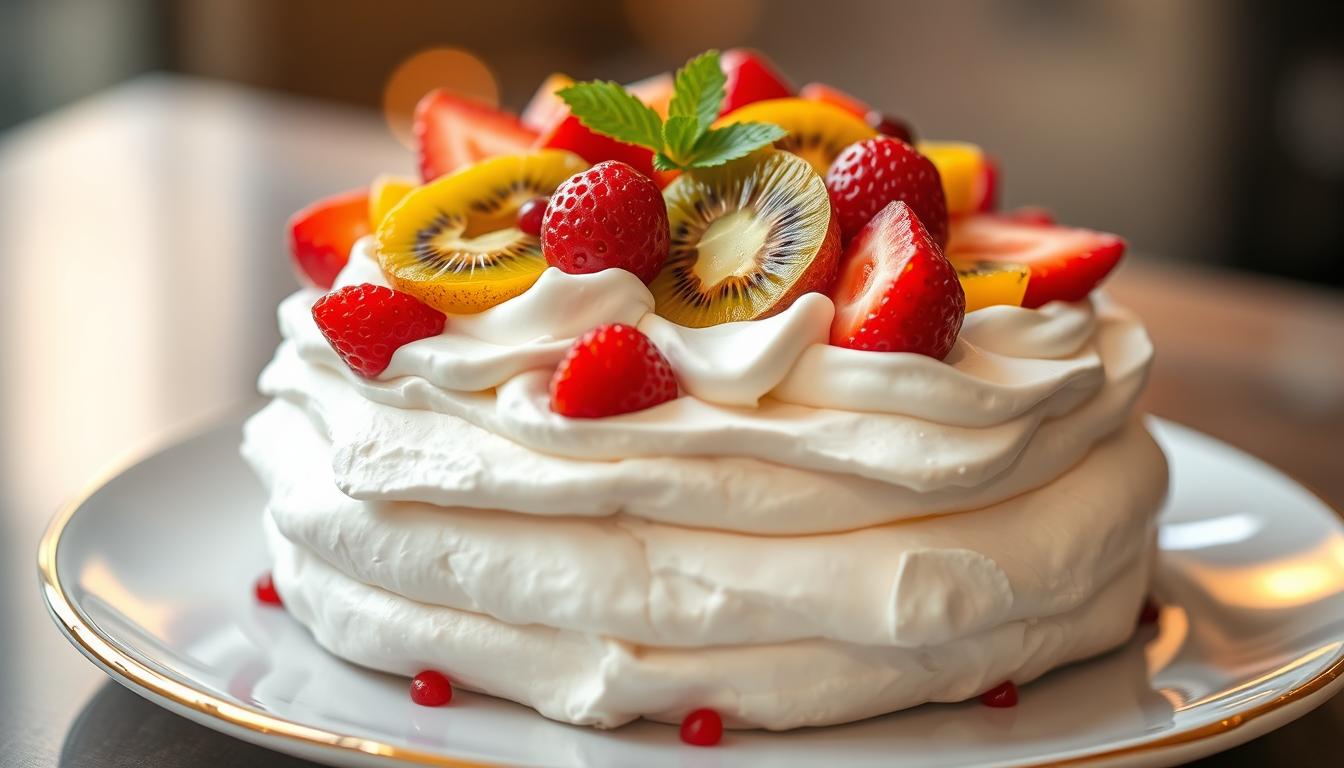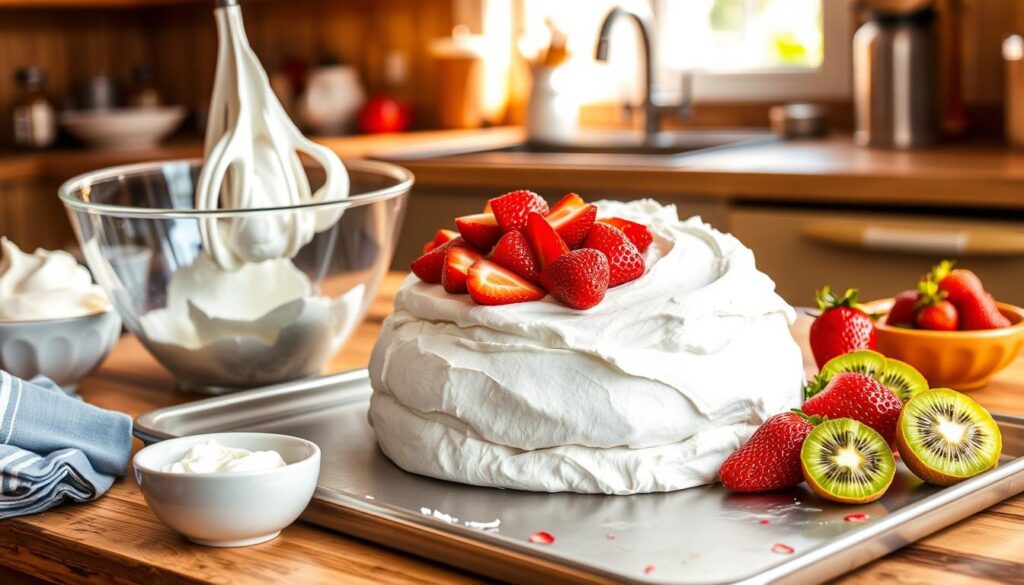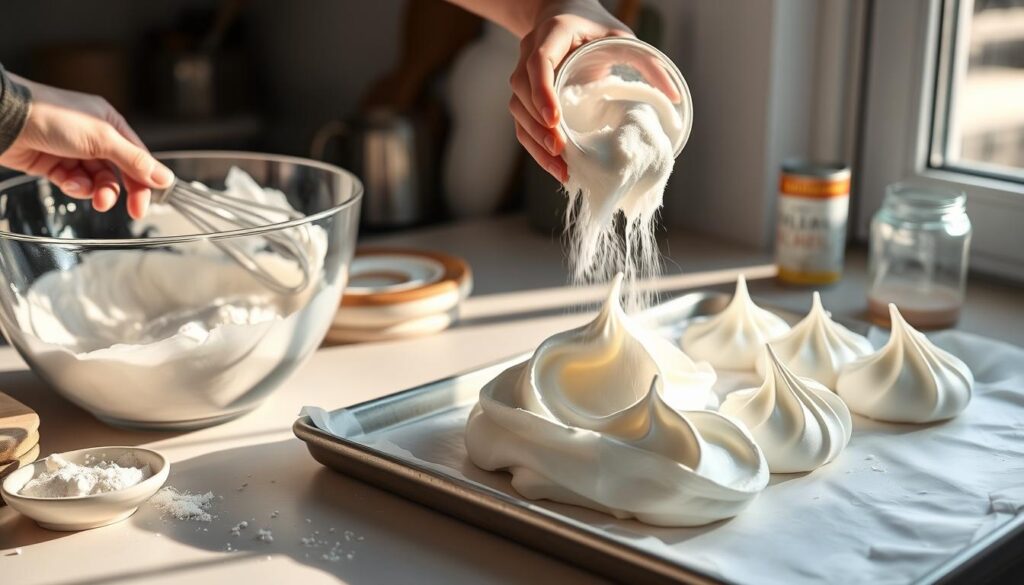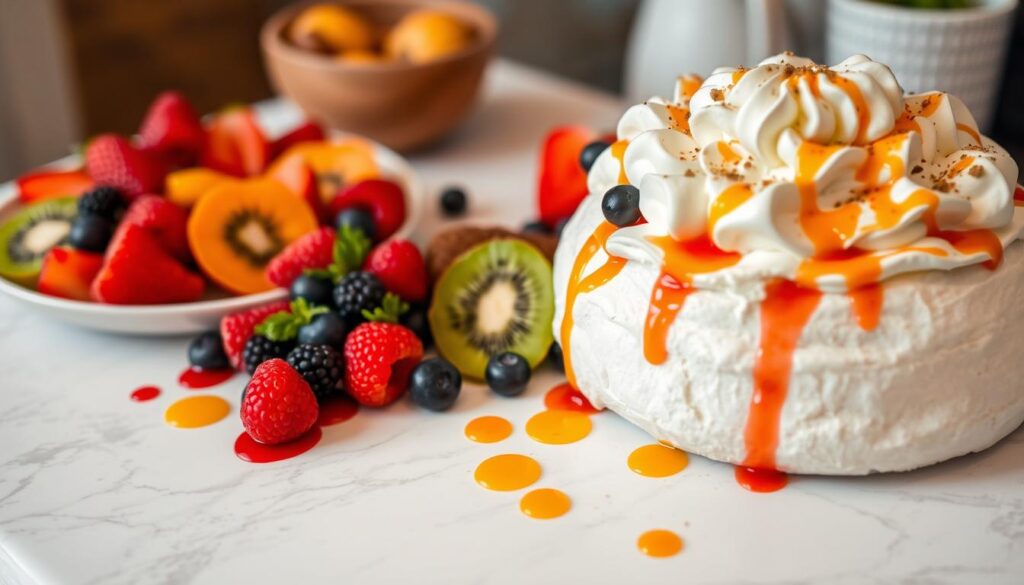Looking at a freshly baked Pavlova, I feel pure joy and excitement. This classic dessert from Australia and New Zealand is loved for its light meringue, whipped cream, and fresh fruit. Making the perfect Pavlova might seem hard, but I’ll show you how to do it step by step. This way, you can enjoy this delicious treat at home.
Key Takeaways
- Pavlova is a beloved meringue-based dessert originating from Australia and New Zealand.
- It features a crisp exterior and a soft, marshmallow-like interior, crowned with fresh fruit toppings.
- This comprehensive guide will teach you the essential techniques and tips to create a stunning Pavlova at home.
- Learn about the key ingredients, necessary equipment, and step-by-step instructions for baking the perfect Pavlova.
- Discover expert advice on mastering meringue techniques, troubleshooting common issues, and showcasing your Pavlova with beautiful fruit and cream toppings.
Understanding Pavlova: A Classic Australian and New Zealand Dessert
Pavlova is a beloved meringue-based dessert in Australian and New Zealand cuisine. It was named after the famous Russian ballerina, Anna Pavlova, in the 1920s. The dessert’s light, airy texture and sweet taste remind people of the ballerina’s grace.
History and Cultural Significance
Pavlova has become a key part of Australian and New Zealand culinary traditions. It’s a national dish, loved by families and communities. They enjoy it during special occasions and holidays.
Key Characteristics of Perfect Pavlova
A perfect Pavlova has a crisp exterior and a soft, marshmallow-like interior. The meringue base is perfectly balanced, offering a sweet taste without being too much. This balance makes the perfect Pavlova a true delight.
“Pavlova is a true culinary masterpiece, celebrating the art of balancing flavors and textures to create a dessert that is both visually stunning and deliciously satisfying.”
Essential Ingredients for Classic Pavlova meringue dessert
Making a classic Pavlova, a famous meringue dessert, needs the right ingredients. Egg whites are key for its light and airy texture. With granulated sugar, they become a shiny, stiff meringue that’s the Pavlova’s base.
Cornstarch and vinegar are also crucial. Cornstarch keeps the meringue stable, while vinegar adds a slight tang. This balances the dessert’s sweetness.
| Ingredient | Purpose |
|---|---|
| Egg Whites | Provide structure and volume to the meringue base |
| Granulated Sugar | Sweetens the meringue and contributes to its glossy, stiff texture |
| Cornstarch | Stabilizes the meringue, helping it hold its shape during baking and cooling |
| Vinegar | Adds a subtle tanginess that balances the sweetness of the dessert |
Choose high-quality, fresh ingredients for the best Pavlova. Make sure egg whites are room temperature and sugar is fine-grained. With these ingredients, you’ll make a classic egg white dessert that’s perfect.
Kitchen Tools and Equipment Needed
To make the perfect Pavlova, you need the right tools and equipment. Whether you’re an experienced baker or new to Pavlova, having the right tools is key. They help you get the right texture and look for your dish.
Must-Have Baking Tools
- Electric mixer: A strong stand mixer or hand mixer is crucial for whipping egg whites to stiff peaks.
- Baking sheet: A solid baking sheet or sheet pan is needed for baking the Pavlova meringue.
- Parchment paper: Parchment paper on the baking sheet prevents the Pavlova from sticking and makes it easy to remove.
- Mixing bowls: A large, clean, and grease-free bowl is important for whipping the egg whites.
- Whisk: A handheld whisk or the whisk attachment of your electric mixer helps mix air into the egg whites.
Optional but Helpful Equipment
While not necessary, these tools can make baking your Pavlova easier and more fun:
- Piping bag and tips: A piping bag lets you create fancy swirls and peaks on your Pavlova.
- Offset spatula: This tool makes it easy to move the Pavlova meringue from the baking sheet to a serving platter.
- Culinary torch: A kitchen torch can give your Pavlova a caramelized, golden-brown crust.
Preparation Setup
Before baking your Pavlova, make sure your workspace is clean and organized. Have all your ingredients and tools ready. Also, preheat your oven to the right temperature. This setup helps you follow the baking techniques and how to make Pavlova smoothly and efficiently.
How to Make Pavlova: Step-by-Step Instructions
Making the perfect pavlova, a famous meringue dessert recipe, is a fun journey. Follow these steps to make your own rich egg white dessert at home.
Start by carefully separating the egg whites from the yolks. It’s important to avoid any yolk to get the right meringue texture. Then, beat the egg whites until they become stiff and shiny.
- Add sugar slowly, one tablespoon at a time, while beating the egg whites. This helps make a smooth meringue.
- Mix in any flavors you like, like vanilla or lemon zest, until they’re fully incorporated.
- Spread the meringue on a baking sheet into a circle with a slight dip in the middle. This makes room for the filling.
Bake your pavlova at a low temperature for about an hour. It should be crispy on the outside and soft inside. After baking, turn off the oven and let it cool completely, which can take hours or overnight.
| Step | Action |
|---|---|
| 1 | Separate egg whites from yolks |
| 2 | Beat egg whites until stiff peaks form |
| 3 | Gradually add sugar while beating |
| 4 | Fold in any desired flavorings |
| 5 | Shape and bake the meringue |
| 6 | Allow the pavlova to cool completely |
With these easy steps, you’re ready to make a stunning pavlova that will wow everyone. Enjoy the journey of how to make pavlova and relish the tasty meringue dessert recipe.
Mastering Meringue Techniques for Perfect Texture
To make the perfect Pavlova, you need to master meringue. Paying attention to egg white prep and whipping is key. This ensures a crisp outside and a soft inside.
Egg White Preparation Tips
Separating eggs carefully is essential. Make sure your egg whites are yolk-free to whip properly. Also, use room temperature egg whites for better volume and stability.
Achieving Stiff Peaks
Whipping egg whites to stiff peaks is crucial. Start with low speed and increase as needed. Stop when they’re glossy and hold their shape. Be careful not to over-whip, as it can make the meringue dry.
Common Meringue Mistakes
- Introducing fat or moisture: Any trace of yolk, oil, or water can prevent the egg whites from whipping properly.
- Under-whipping: Soft, runny meringue will result in a Pavlova with a soggy texture.
- Over-whipping: Excessively stiff meringue can lead to a Pavlova with a dry, cracked surface.
- Baking at the wrong temperature: Incorrect oven temperature can cause the Pavlova to brown too quickly or collapse during cooling.
Mastering these meringue techniques will help you make a Pavlova with a perfect texture. You’ll get a crisp outside and a soft, airy inside – the essence of this classic dessert.
Baking and Cooling Your Pavlova
Learning to bake and cool your Pavlova is key to getting it just right. You want a crisp outside and a soft, marshmallow inside. Knowing the best oven temperatures, baking times, and cooling methods will help you make a perfect Pavlova every time.
Start by heating your oven to about 225°F (110°C). This low heat helps the meringue get a crisp exterior while keeping the inside soft and marshmallow-like. Bake your Pavlova for about 1 hour to 1 hour and 15 minutes. Keep an eye on it to avoid it getting too brown.
After baking, don’t take the Pavlova out of the oven right away. Turn off the oven and leave the door a bit open. This slow cooling helps prevent cracks and keeps your Pavlova looking great.
When it’s completely cool, move the Pavlova to a serving platter or cake stand. Now you can add your favorite toppings, like fresh fruit and whipped cream. This will make your dessert look and taste amazing.
“Patience and attention to detail are the keys to achieving a perfect classic Pavlova meringue dessert every time.”
| Oven Temperature | Baking Time | Cooling Method |
|---|---|---|
| 225°F (110°C) | 1 hour to 1 hour 15 minutes | Turn off oven, leave door slightly ajar |
Fresh Fruit Toppings and Decoration Ideas
Take your Pavlova to the next level with fresh fruit toppings and creative decorations. The light meringue base is perfect for showing off fresh fruits. You can use vibrant seasonal fruits and create beautiful arrangements.
Seasonal Fruit Combinations
For a stunning classic Pavlova meringue dessert, use the freshest fruits in season. Try strawberries, raspberries, and blueberries for a classic look. In fall, peaches or nectarines add a sweet touch. For winter, oranges, grapefruits, or pomegranate arils offer a refreshing twist.
Artistic Presentation Tips
- Arrange fruit in a circle on the Pavlova, letting meringue show through.
- Make a striking ombre by layering fruits from center to edges.
- For a natural look, scatter fruit randomly over the Pavlova.
- Add powdered sugar or edible flowers for elegance.
With creativity and an eye for color and texture, your Pavlova will be a hit. Let the fresh fruit toppings and careful dessert assembly be the stars.
“Pavlova is a canvas for creative expression. Let the season’s best produce be your muse.”
Whipped Cream and Sauce Variations
Take your Australian cuisine and New Zealand cuisine pavlova to the next level. Try different whipped cream flavors and tasty sauces. From classic Chantilly cream to unique twists, learn how to boost your dessert assembly.
Chantilly Cream and Flavored Whipped Cream
Start with classic Chantilly cream. Whip heavy cream until it’s stiff. Add vanilla extract, citrus zest, or a bit of liqueur for extra flavor. For a tropical flavor, mix in passionfruit or mango purée.
Complementary Sauces
Match your pavlova with gourmet sauces that highlight its sweetness. Try a berry coulis made from simmered berries and sugar. Chocolate lovers will adore a rich chocolate ganache.
“The key to a perfect pavlova is in the balance of textures – a crisp outer shell with a soft, pillowy interior. Complementing this with luscious whipped cream and flavorful sauces takes the dessert to new heights of indulgence.”
Get creative with whipped cream and sauce variations. Make your pavlova a standout in Australian cuisine and New Zealand cuisine.
Troubleshooting Common Pavlova Problems
Baking pavlova can be rewarding but comes with challenges. Whether you’re experienced or new, knowing how to fix common issues is key. This ensures your pavlova turns out perfectly every time.
Fixing Cracks and Collapses
Cracks and collapses are common pavlova problems. They can be due to over-beating egg whites, sudden temperature changes, or cooling issues. Here are some fixes:
- Gently press the cracks back together with your fingers before serving.
- If the pavlova has collapsed, serve it in a bowl or on a plate, topped with your desired toppings.
- Don’t over-beat the egg whites to avoid a fragile structure.
- Gradually change temperatures during baking and cooling to prevent shocks.
Texture Issues Solutions
A good pavlova has a crisp outside and a soft inside. If you’re having texture problems, try these solutions:
- Beat the egg whites until stiff and glossy before adding sugar.
- Bake at a lower temperature for longer to set the center without drying the outside.
- Adjust baking time and temperature to fit your oven and desired texture.
- Try different baking methods, like using a fan-assisted oven or covering with foil, to control heat and moisture.
Understanding common issues and mastering baking techniques will help you overcome pavlova challenges. You’ll create a dessert that looks great and tastes amazing.
| Problem | Possible Cause | Solution |
|---|---|---|
| Cracks | Over-beating egg whites, sudden temperature changes | Gently press cracks back together, gradually introduce temperature changes |
| Collapse | Over-beating egg whites, improper cooling | Serve collapsed pavlova in a bowl or on a plate, avoid over-beating egg whites |
| Texture issues | Underbeaten egg whites, incorrect baking time/temperature | Beat egg whites to stiff peaks, adjust baking time and temperature |
Conclusion
The Pavlova is a true masterpiece in the world of desserts. It’s a delicate mix of a crisp meringue shell and a soft interior. This iconic treat comes from Australia and New Zealand and has won hearts worldwide.
Making a perfect Pavlova is an art that needs patience and detail. With the right steps and tips, you can make this classic pavlova meringue dessert recipe your own. Add your own flair and touches to make it special.
The Pavlova is more than just a dessert. It’s a symbol of Australian cuisine and New Zealand cuisine. It’s a canvas for your creativity, with seasonal fruits and sauces. Each bite is a taste of history and fresh flavors, making it a true delight.
FAQ
What is a classic Pavlova meringue dessert?
A Pavlova is a classic dessert from Australia and New Zealand. It has a crisp outside and a soft, marshmallow-like inside. It’s topped with fresh fruit and whipped cream.
What are the key ingredients in a Pavlova?
The main ingredients are egg whites, sugar, cornstarch, and vinegar or lemon juice. These create the dessert’s unique texture and flavor.
How do I achieve the perfect Pavlova texture?
To get the right texture, start by preparing the egg whites well. Beat them until stiff, then add sugar slowly. It’s important to avoid yolk contamination and get the consistency just right.
What types of fruit toppings work best with Pavlova?
Pavlova goes well with many fruits. Try berries, kiwi, passionfruit, mango, and citrus fruits. Choose fruits that are in season and match the Pavlova’s flavors.
How do I prevent my Pavlova from cracking or collapsing?
To avoid cracks and collapses, bake at the right temperature and for the right time. Cool it slowly. These steps help your Pavlova stay structured.
Can I make classic Pavlova meringue dessert in advance?
Yes, you can bake the Pavlova base ahead of time. Store it until you’re ready to serve. Just add the toppings right before serving for the best look and taste.
What are some variations on the traditional Pavlova?
You can try different flavors and styles. Add whipped cream or sauces, use various fruits, or make a Pavlova roulade or individual nests. Get creative!




